- Author Arianna Cook [email protected].
- Public 2024-01-12 17:55.
- Last modified 2025-06-01 07:38.
This amazing flower can be grown not only at home, but in the garden. An informative article will tell you about the intricacies of breeding fuchsia. Fuchsia is named after the German botanist Leonard Fuchs, and the flower is native to Central America.
This is a charming plant that pleases with flowers of various colors: red, pink, purple, orange, blue, white. Beautiful, unusual-shaped flowers grow on elongated thin pedicels and look very impressive against the background of small green leaves. So much so that this plant is not only a good decoration for the house, but even for exquisite palaces.
Conditions for keeping fuchsia
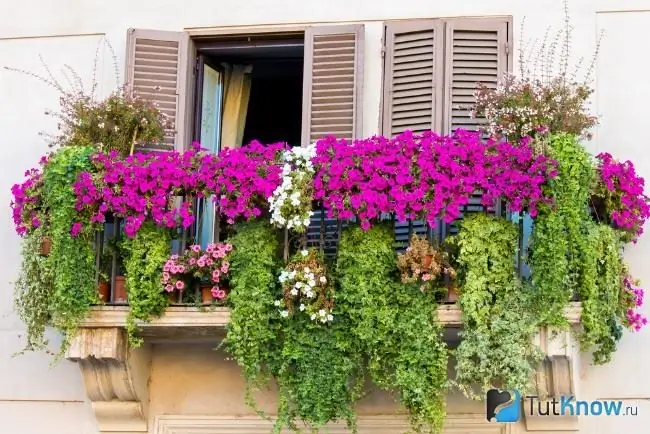
In order for this ornamental plant to please you with its appearance, it is necessary to provide it with optimal conditions of detention: a certain temperature, watering, substrate.
It is better to buy fuchsia soil from a specialty store. If you want to cook it yourself, then mix in equal parts (1: 1: 1: 1: 1):
- humus;
- peat;
- leafy ground;
- clay soil;
- sand.
Pour the mixture into ceramic pots, as plastic pots quickly heat up, this negatively affects the root system of the plant. Place the container on the west or east window - this is where fuchsia will feel best. In any case, immediately provide the plant with a permanent place, since when it blooms, it cannot be transferred, rotated the pot, otherwise the bush may throw off the formed buds and flowers.
They can also fall off if the fuchsia is in direct sunlight, especially if it is hot. In such weather, it is advisable to shade it. If, on the contrary, there is not enough sunlight, then the fuchsia shoots will stretch, which will negatively affect the appearance of the plant and the flowering.
Temperature and water conditions

In order for fuchsia to bloom profusely, provide it with a temperature of at least + 20 ° C degrees. When it fades, lower the temperature to + 10- + 14 ° С. This is to provide the pet with a comfortable environment during the rest period. The plant needs a good rest, then to please the owners with their amazing flowers.
Watering fuchsia should only be pre-settled water. In the summer, this is done 2 times a week, in the spring and autumn - once. In winter, even less so that the land is completely dry between waterings - about 2 times a month. Fuchsia loves to keep the air humid. Therefore, she needs spraying. In the summer, when it's hot outside, it is sprayed in the morning and evening. In autumn and spring - 2 times a week, and in winter this is not done at all.
Fuchsia care
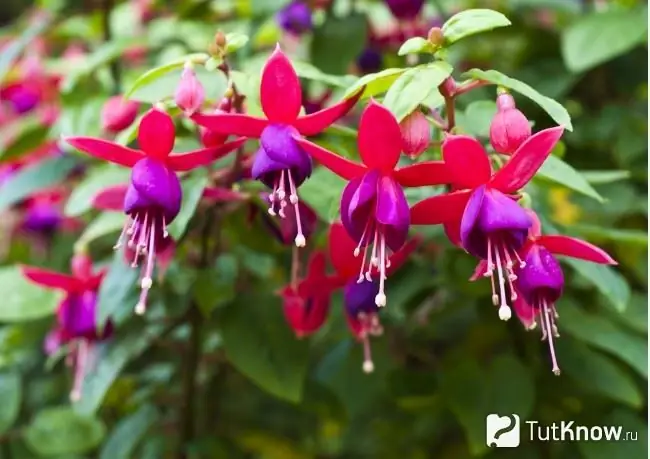
Weak, broken and diseased branches are removed from the plant in autumn and spring, while pinching the plant. This promotes abundant flowering.
In the spring-summer period, 2 times a month you need to feed fuchsia with liquid fertilizers intended for indoor plants. From the beginning of autumn and winter, the flower does not need feeding. After winter, they begin to fertilize it when the buds appear.
Fuchsia is transplanted in early spring. First, it is pruned to the woody place of the stem in order to give the plant a more beautiful compact shape in the future. The container should be with drainage holes and slightly larger than the previous one. Expanded clay is placed on the bottom, and on top - a little ready-made soil or mixed on its own. Thus, the soil is renewed every spring.
Fuchsia propagation
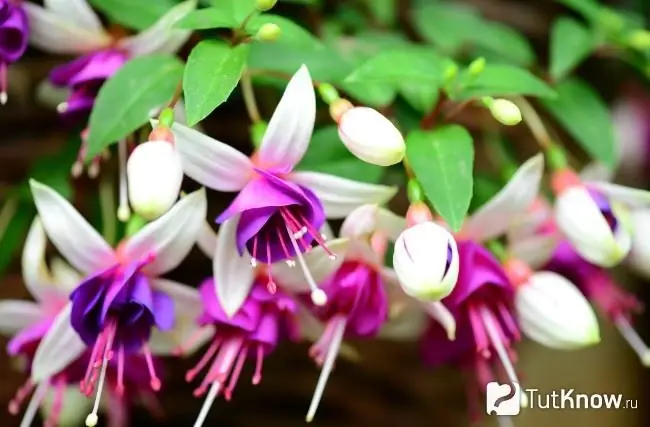
After you have pruned the plant, you can root the cuttings. Fuchsia is propagated by them, seeds and leaves. For the latter method, only the most advanced sheets are suitable. They need to be cut off along with part of the stem and buried 1 cm in light soil. To create greenhouse conditions for them and constant humidity, cover them with a glass jar on top. The appearance of a small rosette at the base of the stem will indicate that you can plant fuchsia in a permanent place.
For the first method of reproduction, you need to choose a stalk, the length of which is 5-8 cm, and there is a bud at the tip. Excess buds must be cut off, leaving the opened leaves intact.
To stimulate root growth, you need to put the cutting in a growth stimulant solution for 2 hours or immerse it in water, and then in a special powdery composition that promotes rooting.
The soil for the cuttings should be light and nutritious. A great option would be a mixture of vermiculite and compost or sand. Usually rooting takes place on day 20-25, then the cuttings are transplanted to a permanent place using a soil of the following composition:
- 2 parts of humus;
- 4 parts of sod and leafy land;
- 1 part sand.
To make the bush more lush, plant several cuttings in one container. Place the plants in a shaded but light enough place, such as a window with a curtain over the glass. Monitor the condition of the soil - it must be moist. If watering is needed, do it with a sprayer, spray the cutting itself in the same way, if there are no signs of evaporation under the jar. It is not necessary to water the fuchsia at this stage of propagation in the usual way, otherwise you can damage the roots or they can rot.
When additional stems appear, it means that the roots have become strong enough and the plant can be transplanted to another place. You can immediately in a large pot, but then you need to take special care of the moisture content of the soil. If you first plant it in a small one, then when the fuchsia takes root and grows, you need to transplant it into a more spacious container.
Growing garden fuchsia
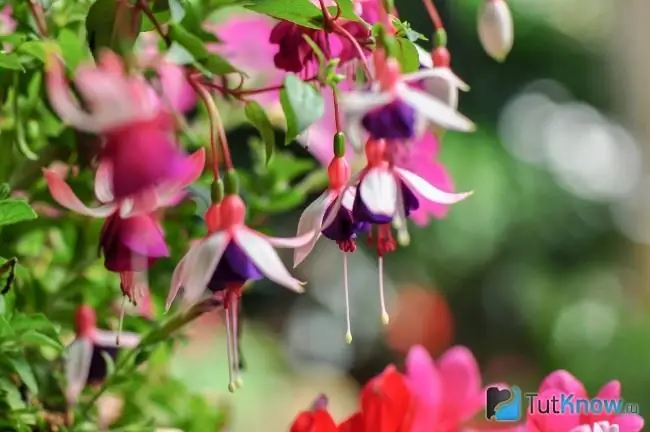
If you have a summer cottage or a site in front of a city house, you can plant this plant there for the summer. Then you need to buy or root a stalk of flowerbed fuchsia as described above. You can grow fuchsia from seeds by planting seedlings in March. Such a plant will bloom 4-5 months after planting and will delight the gardener with its charming blooming buds from July until the first frost.
You can shape the fuchsia into a familiar bush or turn it into a mini-tree. Then you need to remove all lateral shoots at the bottom of the stem. Pinch the top from time to time so that the plant forms a huge bouquet. If desired, ampelous fuchsia with straight shoots is formed in such a standard form. To prevent the wind from breaking the trunk, the plant must be tied to a reliable support.
From the fuchsia variety "Celia Smedley", a particularly beautiful tree is obtained, which grows quickly, which allows it to turn into a tall standard plant within 2-3 years.
Here are some other fuchsia varieties you can plant:
- Kobolt;
- Joan Pacey;
- Postiljon;
- Mantilla;
- Uranus;
- Minirose;
- Royal Velvet.
If you want to buy fuchsia of continuous flowering, then pay attention to the varieties:
- Kobolt;
- Dollar Prinzessin;
- Minirose.
Fuchsia garden care

Like homemade, garden fuchsia (most varieties) does not like direct sunlight. Therefore, you need to give the flower a place in partial shade. Otherwise, in the hot midday hours, the leaves will get burned. Plant the plant in an area that is only well lit by the morning sun - on the east side.
A hole is dug 15 cm deeper than the height of the pot in which the fuchsia was located. Fill the bottom of the pit with drainage, a mixture of compost with manure and turf soil. Plant a plant with a lump of earth, sprinkle the root system with soil of the same composition.
Water garden fuchsia in the morning or evening when the topsoil begins to dry out. Tear off withering flowers periodically. After all, if they begin to form seeds, then the plant may stop blooming. Fuchsias love evening and morning showers.
Fertilize once a week or once every 2 weeks, until August, preferably with liquid fertilizer, which will stimulate flowering. You can apply long-acting granular fertilizers when planting in a hole, then additional fertilizing during the season is not required.
In the fall, dig out your pet, transplant it into a pot with drainage and transfer it to a dark, cool room, where the temperature is + 2- + 5 ° C, so that the plant will rest until next summer.
Moderate soil moisture must be maintained. After all, if the earthen lump dries up, the shoots will begin to dry out.
Fuchsia pests and diseases
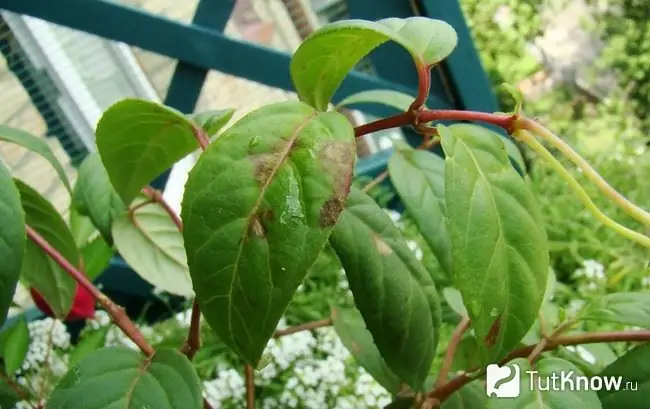
Garden fuchsia can be attacked by whiteflies and leaf aphids if you plant it in a warm place with little to no wind. It is better to fight these pests on a flower with folk remedies, but you can also use commercial industrial ones, diluting them strictly according to the instructions.
Indoor fuchsia is not often subject to disease. Like the garden one, it may show signs of powdery mildew due to the very high humidity. Excessive watering or heavy rainfall can lead to root rot. It is also impossible to overdry the soil, otherwise the buds and leaves may fall off. Drafts, plant rearrangement sometimes lead to this. Sometimes the hot conditions of the fuchsia are conducive to the attack of the red spider mite.
This is how she is, beautiful and unique fuchsia. You will certainly be able to grow it if you love and properly care for the flower.
For more information on growing fuchsia at home, see this video:






